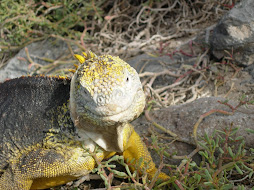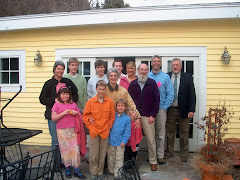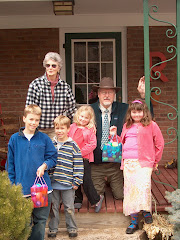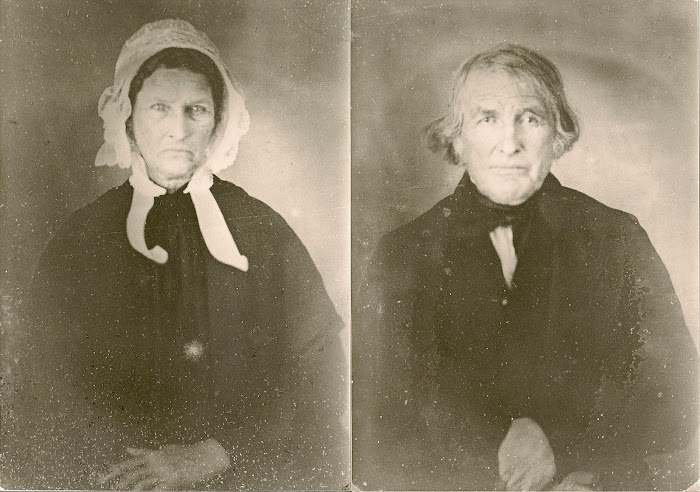Happy, as ever, for the reminders that family history is always a work in progress, that by sharing what information we have, we invite additions and revisions to the stories. It's always a bit of a guessing game as to what information might be correct, what might be "real" and what might be fabricated, or simply erroneously copied, drummed up, or imagined. But it's well worth the effort to make a stab at getting to the truth--it's a nice way to dignify a life.
I heard from my Great Uncle Mase regarding my story on Agnes Dunn, and he was able to fill in some of the gaps. His mother had extensive notes which she got from her mother, Eliza May Mason Gardner, whom Mase and my grandfather called Mother May. Mase is also going to send me the family tree that he put together after his Aunt Arlene went to England and Scotland and went sleuthing in graveyards and public records offices. It sounds like it was a fruitful expedition. I am excited to put more of the pieces together! And when I do, I'll revise Agnes' tale yet again--though I am certain it will not be the last time.
Monday, August 23, 2010
Saturday, August 21, 2010
Where art thou, Agnes Dunn?
 |
| Perhaps Agnes played at this castle. |
Agnes was my great, great, great grandmother, my father's father's mother's mother's mother. Little bits of Agnes live on in me, and I am infinitely curious about her, this woman from Scotland who lived in England, New Zealand, and Australia, before coming to the US, where she died in Brockton, Massachusetts, a place where the Bettridges and the Masons and the Watts and the Gardners came together in the 19th century to spawn Gardner Brothers and WB Mason and a whole host of offspring. Agnes, like most women of her time, it seems, is ever elusive in the mix.
 |
| Dundee, Scotland, 1821 survey |
A few records show that she might have been born on March 10 or 11 in 1808 in Dundee, Angus, Scotland, where the habitational surname of Dun and Dunn (named with Gaelic dun, meaning 'fort') originated in Angus, spreading into the far corners of the world, and littering the Howff Graveyard of Dundee with Dunns of all kinds. Some of these Dunns might have been Agnes' parents--John Dunn, for instance, the "scavenger," who lost a baby daughter Ann to "teething;" or a different John Dunn, the "labourer," whose daughter Mary Ann died of "convulsion fits" at the age of three months, and whose wife, Mary, seems to have died just two years later, of "consumption;"; or perhaps Thomas Dunn, the "shipmaster" whose daughter Mary died of "water in head" as a young tot. Life, no doubt, was harsh. Graveyard records are filled with premature deaths from things that we can manage quite well today--asthma, teething, influenza, fevers and inflammation--or which have been thankfully eradicated--smallpox, cholera, measles. There are a few oddities amongst the causes of death--"chincough," which, after a little research in Webster's 1828 English Dictionary, I discovered is just another name for whooping cough; "heamoptosis," which is the act of coughing up blood; "synochus," or continuous fever, and "bowel hive," which I don't even want to think about. There are very few people who have died of "old age," and they are all women: Ann, at 84, takes the prize for longevity. Some of the other elder Dunns died of things like "worn out constitutions," "asthma," and "lung complaints." But truly, it is the babies, that take center stage, and their anguished mothers and fathers, that make your heart ache, and the Dunns experienced more than their fair share of loss. It must have been brutal.
Whether Agnes' parents were John and Ann, or some other pair, I don't think I'll know until I head to Dundee and do a little research there. For now, it is interesting enough to explore and imagine the possibilities.
There is some evidence that Agnes first married John Hamilton from Glasgow. Five years her elder, he might have been the father of her daughter, Agnes, but no other information is known. John Hamilton died in 1873 in Glasgow, so if they were married, the circumstances of her departure are circumspect.
 |
| ca. 1835, Robert Creighton, engr. J. & C. Walker for Lewis' Topo Dictionary |
 |
| Stonehenge |
What would have led Agnes to go to Salisbury is unknown, but given the general challenges brought on by the industrial age in the UK, it seems like a time when many ordinary folks were struggling to make ends meet and to find a better way. Those who had a little bit of moxie in them took the leap that led them and their families to new opportunities elsewhere.
It is apparent that Arthur and Agnes followed the wave of migrants from Salisbury, which resides in Wiltshire, a southwest county of England that was rich in copper and tin mining at the time, to Auckland, New Zealand, where their first child, a son named Arthur J. Dunn, was born two years later, on May 24 1843. It could be that the depression in the 1840's in Wiltshire, brought about partly by a reduction in the mining, forced them to find a better life somewhere else. Or perhaps they were intrigued by the promise of a new life, and bought into the marketing blitz made by the New Zealand Company, who was eager for new settlers. About half of all the 19th-century English immigrants to New Zealand came on assisted passages, mostly through the New Zealand Company, who were recruiting heavily in the Wiltshire area for farm labourers and craft workers who could provide the necessary skills to recreate English society and culture in New Zealand. Between 1839 and 1850, over 85% of those who emigrated did so with close family members. And Auckland's land grant scheme, which awarded immigrants land orders based on family size, further encouraged these greater family and chain migrations.
I don't know whether Agnes and Robert migrated with any other family members, but they seemed to have settled in fairly quickly, having Arthur, Elizabeth and Ann in Auckland over just a couple of years (Elizabeth may have died in infancy). There is more than one indication that Arthur, their first son, may have been born in Dublin, Ireland, but it doesn't seem to make much sense. The only reason why I mention it at all is that their daughter Janet Caroline Bettridge, my great great grandmother, was born not in Auckland, like her brother and sisters, but rather in Sydney, Australia, on October 4, 1846. The Australia Birth Index from 1788-1922 lists a Caroline J Betteridge born in 1846 to Arthur Betteridge and Agnes in New South Wales. Not sure if the spelling difference is indicative of a change the family might have made during one of their relocations, or just a typo (see below: Bettridge is obviously and indeed a variation on Betteridge). Just what did her father do for a living that brought them from England to New Zealand to Australia (and later, back again)? Was he a mariner or in the military? A younger brother, Robert W. Bettridge, was born in 1849 in Auckland, indicating that the family had returned after a possible longer stint or short excursion in Sydney. It gives some credence to the notion that Arthur could have been born in Dublin, if they were doing a lot of moving around or traveling at the time.
As well, if Arthur the father had been in the military, it was frequent policy for British soldiers to be assigned to different posts in not only New Zealand but Australia as well, and this could explain why some of his children were born in Auckland, while Janet was born in Sydney. The Harriet Affair of 1834, when a group of British soldiers of the 50th Regiment from Australia were sent by Governor Bourke from Sydney to rescue the wife and children of Jacky Guard, infamous whaler and trader, in Taranaki, NZ, and punish the kidnappers, and ended up being criticized for excessive use of force, illustrates well the use of British military from one British colony--Australia--to quell unrest in another British colony--New Zealand.
Arthur Robert Bettridge, the father of Janet, would die just three years after his youngest son, Robert, was born. And quite fittingly, he would die not in Auckland, where Robert was born, but in Merton, New South Wales, Australia, on August 3, 1852. The Bettridge family, then, appears to be living in Australia during this time. Eldest son Arthur would emigrate to the US in 1860, just at the start of the Civil War. Just one year into his new residency, he sought to take part in a historic war that would redefine the country that would later become his family's new home. In 1861, he enlisted Company 1, 12th Massachusetts division of volunteers, and after a year, transferred to the Navy, where he would serve until 1864. He would spend the next four years at sea, another indication that his father, perhaps, had been a mariner, military man, merchant, or seaman of sorts.
MASON - BETTRIDGE
January 15, 1848, at Edwardes-street Chapel, by the Rev J Long, William, eldest son of Mr Wm Mason, to Janet Caroline, second daughter of the late Mr Arthur Bettridge, of Whiteparish, Wilts., England. [NZ'er 63rd Regt May 1848]
January 15, 1848, at Edwardes-street Chapel, by the Rev J Long, William, eldest son of Mr Wm Mason, to Janet Caroline, second daughter of the late Mr Arthur Bettridge, of Whiteparish, Wilts., England. [NZ'er 63rd Regt May 1848]
During this time, Arthur's sister Janet, our Janet, married the dashing (he must have been) William C. Mason, who had been born in Hastings, England on March 11, 1840, and had come to Auckland with his family as part of the same wave of migration that had spurred Janet's family to leave their home, move to a new continent, and embrace a new beginning. Despite what the above passage backed in gray says, Janet was just 18 when she married William on January 15, 1864, (not 1848, which would have put her at three years old!)--and they were married not in Auckland, New Zealand, but in Sydney, Australia, where it seems Janet, her mother Agnes, sister Ann and brother Robert were still living after their father had passed away in 1852. It is possible that the oldest son, Arthur, was somehow supporting the family at this time. What's curious about the bit in gray is that despite getting the date wrong (the January 15 is correct, of course), the rest of the information seems to be accurate--and quite helpful. Janet's father was, apparently, a military man, a "New Zealander of the 63rd Regiment" in 1848. English colonization of New Zealand set off the inevitable battles for sovereignty between settlers and natives, and Bettridge may well have taken part in the skirmishes of these New Zealand Wars that began in 1843 and began to wind down with Titokowaru's War in 1869. In any case, Arthur Robert Bettridge died in 1852 at a young age, quite possibly of illness or of injury, battle or otherwise. He left behind his wife, Agnes, and four children, who would soon be busy with offspring of their own. How did Agnes cope?
 |
| Great Uncle William's company logo |
A daughter, Sarah Agnes Mason, followed WB in December of 1866, and in 1868, Uncle Arthur returned to New Zealand, and worked with the Revenue Service until 1870. On January 28, 1869, his sister Janet, still at Mount Saint Mary, would give birth to my great grandmother, Eliza May Mason, who would be joined by a younger sister, Edith Winnifred Mason, on November 17, 1870.
Sometime in 1870, Uncle Arthur returned to the US, settling in Brockton, Massachusetts and working as a carpenter for five years. Five years later, he would move to Pettis County, Missouri, marry Rebecca Jeffries, and then make his way back to Brockton, where he would end out his days, dying on August 17, 1896.
There are some clues as to when the rest of Arthur's family might have come over, but a lot remains buried. Agnes must have come over once her son Arthur had settled in, or perhaps, they came together, but there is greater evidence to suggest that she came sometime between January of 1871 and 1873. When she died, in Brockton, at the age of 65, on December 29, 1873, she had outlived her husband by more than twenty years. Agnes also outlived her son-in-law, William C. Mason, who tragically died at the age of 31 on January 28, 1871, in Auckland. If this is so, Janet must not have come to Brockton until after his death in 1871. Her children would have been so very young--6, 5, 2, and 1--and I can't imagine that her mother left her at this time to go to Brockton without her, or before her, so it makes sense that Agnes must have stayed in Auckland to help Janet with her children before they all came to the US sometime after January of 1871. Difficult times often bring families together; perhaps Janet's older brother Arthur offered assistance at this time, and the family followed him to Brockton.
City Directories and Census reports would tell me a whole lot more, and I'll get on it, but for now, I am too cheap to pay the monstrous subscription prices at Ancestry.com that would allow me to research such places from the comfort and convenience of my home. I suspect that all the Masons and Bettridges might have come over to Brockton and lived close by, if not with each other. I would imagine that Agnes, mother of Janet, and grandmother of Eliza May, most likely lived with Janet and her family. After all, both women were widowed, and it must have been awfully difficult to get along without each other. It is no wonder that WB went on to become such a successful businessman, driven as he was by his circumstances of most likely having to provide for his family at a young age. In fact, the 1880 census shows that Janet was heading a house on Ford Street, her four children living with her. Her son William B., at the age of 15, is already working full time as a clerk in a clothing store. His mother, Janet, is working as a seam stay maker. Sarah (13), Eliza May (11), and Edith (9) are all "at school." The census also serves to confirm the birthplaces of everyone, as well as their parents. In this five-some, Australia, England, Scotland, and New Zealand are all represented, a veritable British empire.
 |
| The Mason-Five in 1880 |
Agnes Dunn Bettridge died on the 29th day of December in 1873, in Brockton, Massachusetts. She was, as I've said, 65. She had lived in five countries on four continents, gave birth to as many as six children, and watched them grow and prosper and have children themselves.
Her granddaughter, Eliza May Mason, went on to marry Emanuel Washington Gardner, son of Eliza Watt and Silas Gardner, who had come over from Stockport, England in the early 1800's to make his way in the fruit and vegetable business, which his two sons, Silas and Eliza's husband Emanuel, eventually took over and named Gardner Brothers. Eliza Watt was the daughter of Robert Watt and Elizabeth Malcolm, both from Scotland. Eliza May and Emanuel married on November 14, 1888, and lived in Brockton, where they had several children, including my grandfather, Donald Watt Gardner. In 1898, WB Mason started his rubber stamp company. His mother, Janet Caroline Bettridge Mason, died on September 12, 1915 in Brockton, at age 69. Janet's daughter, May would die on January 26, 1938, while visiting her daughter in Marblehead, three years after her husband, Emanuel, had died.
A few interesting surname tidbits: In Scottish, Dunn is a nickname from the Gaelic, donn, meaning brown. In English, it was a nickname for a man with dark hair or a swarthy complexion, from the Middle English dunn, meaning dark colored. In Irish, it is a reduced Anglicized form of Gaelic Dun:
Ó Duinn, Ó Doinn ‘descendant of Donn’, a byname meaning ‘brown-haired’ or ‘chieftain’. More likely, Dunn is the Scottish habitational name from Dun in Angus, where Agnes was from, named with Gaelic dùn‘ fort', meaning a heap, hill, mount; a fortress, a castle, fastness, a tower.
Bettridge is indeed the reduced form of Betteridge, as in I am better than you. That's a joke--just all that phony British enthnocentricity talking. It's actually from the Old English personal name Beaduric, composed of the elements beadu ‘battle’ + ric for ‘power’. Huh. Battle power. I guess I am better than you. ;)
Mason is of course an occupational surname. Somewhere in our past we've got an ancestor who made things, and in particular, worked with stone to make things, cool things no doubt, given the importance of stone masonry in the Middle Ages, when the surname originated. It comes from the Old French maçon (of Germanic origin, connected with Old English macian to make). The Masons, incidentally, come from northern England; as well, there was, in 1891, a fairly high number of Mason families in Angus, Scotland, too.
Watt is from the Scottish and the English, from an extremely common Middle English personal name, Wat(t), a short form of Walter.
And as for my last name--Gardner--well, let's just say that my great grandfather Emanuel and his brother Silas were carrying on the family traditions when they operated Gardner Brothers fruit and vegetable wholesale and retail market in Brockton. Not only had their father, Silas, sold fruit and such on the streets as a huckster, but their grandfather, also named Emanuel, was from Timperley, England, which served as a market garden for Manchester. And still, it goes on long before that. Gardner is a form of Gardener, from the Anglo-Norman French gardinier, meaning gardener, as in, a cultivator of edible produce in an orchard or a kitchen garden. Sounds a whole lot like me! Off now, to pick some raspberries and tend to the overflowing vegetable garden in the back yard. Happy sleuthing! ~ ESG
Subscribe to:
Comments (Atom)




